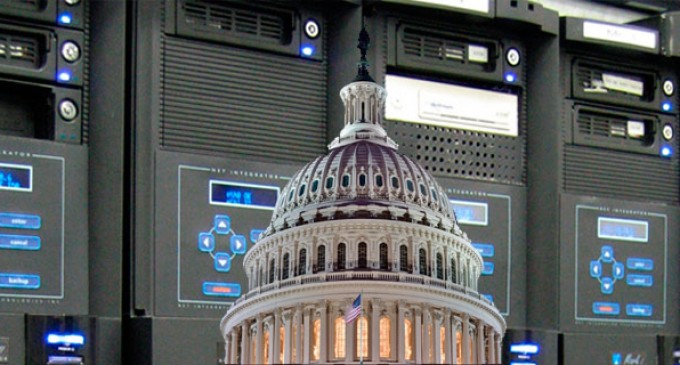
A tech startup company in California, PlaceAVote, would like legislation to be voted on by citizens, replacing Congress.
“If a PlaceAVote candidate is voted into office, all bills that come before Congress will be decided by the district via majority vote online,” states the company’s web site.
The company has 2 candidates running for Congress who promise to vote according to tallies from the public.
More details from their website:
1. Registered voters can place a vote on all bills that come before the United States Congress.
A. They can place or change a vote as soon as the bill is made publicly available.
B. Voting ends 15 minutes before the elected representative is required to place their vote.
2. Registered voters can choose to delegate their vote to another registered voter in their district.
A. Registered voters may be allowed to temporarily withdraw delegation for a single issue.
3. Registered voters get real-time stats on the status of any vote at any time.
4. Registered voters can view their historical votes.
5. Registered voters can audit their vote and insure that it was counted.
6. Registered voters can discuss bills through a forum-style format.
7. Registered voters can quickly and clearly understand all the riders on a bill.
8. Bills will be summarized outlining key elements such as costs, who benefits, who pays and who or what industry lobby wrote the bill.
9. Registered voters can suggest new bills.
10. If a bill is authored by the district, it must receive majority vote before it is proposed in committee.
Your thoughts?
The startup, PlaceAVote, envisions Americans voting on legislation through their software system and is currently running two candidates for Congress, both software engineers, who vow to vote according to the tallies recorded by the system.
“If a PlaceAVote candidate is voted into office, all bills that come before Congress will be decided by the district via majority vote online,” states the company’s web site.
One of PlaceAVote’s candidates, John Catano, said that the Founding Fathers “designed a political system that countless others have been based off of.”
“That being said, if they had access to current technology, don’t you think they would use some of it to address the will of the people?” He asked.
While the push to bring back power to the individual is encouraging, especially when the congressional approval rating is in the single digits, there are, however, some pitfalls with the concept, which appears to revolve around the “will of the majority.”
For one thing, the creators of PlaceAVote announced they are “committed to democracy.”
But America was founded as a republic under the rule of law with respect to individual liberties, not as a democracy which only leads to mob rule fueled by the unrestrained whims of the public.
“Democracy is the ‘direct’ rule of the people and has been repeatedly tried without success,” states a U.S. Army training manual from 1928. “Our Constitutional fathers, familiar with the strength and weakness of both autocracy and democracy, with fixed principles definitely in mind, defined a representative republican form of government.”
“They made a very marked distinction between a republic and a democracy and said repeatedly and emphatically that they had founded a republic.”
In other words, the Founding Fathers did not want a democracy in which the birth rights of the minority could be voted away by the majority.
Additionally, there is always the possibility that voting software can be manipulated or hacked by corrupt officials, allowing the establishment to flip votes in its favor while also giving individual voters the false impression that they are more empowered than ever before.
It’s been well documented that electronic voting machines, for example, are extremely vulnerable to voting fraud.
The Government Accountability Office even admitted as far back as 2005 that it was possible for voting staff to alter electronic ballots without being detected.
“This critical finding confirms that rigging the 2004 vote did not require a ‘widespread conspiracy’ but rather the cooperation of a very small number of operatives with the power to tap into the networked machines and thus change large numbers of votes at will,” the GAO declared in its report on the 2004 presidential election. “With 800,000 votes cast on electronic machines in Ohio, flipping the number needed to give Bush 118,775 could be easily done by just one programmer.”
While steps should be taken to empower the individual in the face of collective tyranny, attempting to do so with mobocratic concepts and fallible technology is fraught with danger.

A scam looking for a problem.
We can give the voters a voice but we will make sure theyre picking between bad and worse.
If this can be done securely without fraud it is an excellent idea. I think it can be done. I can’t believe some of the comments. This would be the first time your vote actually counted.
That is just way to easy to defraud.
Maybe we should have a visible vote. Everyone that wants to vote yes goes outside at say 10 a.m. and a drone can fly by and count the votes, verifying every vote with a picture of confirmation of the person actually placing the vote.
Today’s politicians will never let them get elected.. To much corruption at the highest level.
I freakin love this idea!!!!
Great idea… and Mr. Perry, if there is a way to verify that the voter is registered to vote in that state, you could eliminate your “drone”.
It seemed like a good idea at the time ?
As long as the software is public, not proprietary. Open for public review and verification.
its a simple idea , i can even build it and it would work if every has a voters id